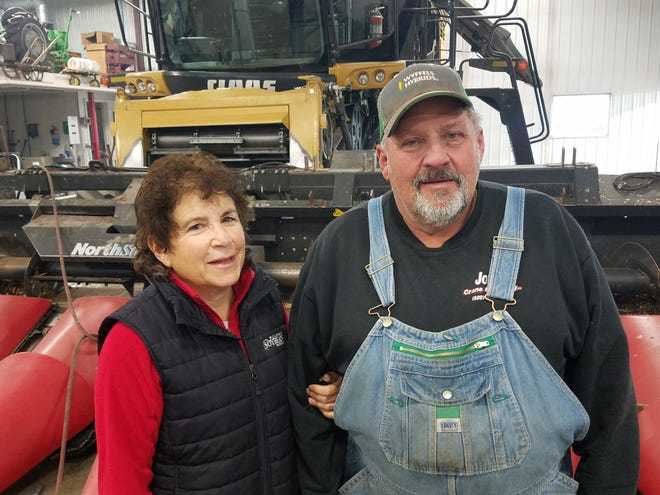 Charlie Hammer and Nancy Kavazanjian of Kavazanjian Farms are Leoplold Award nominees for their ongoing committment to soil conservation and water quality. - photo credit: Gloria Hafemeister, Wisconsin State Farmer
from Wisconsin State Farmer
The Thanksgiving dinner table conversation among siblings who grew up in the urbanized Long Island, New York area is not likely to be about farming and phosphorus management but that’s just the kind of conversation Nancy Kavazanjian and her brother, a scientist and researcher at the Arizona State University had nearly three years ago.
Kavazanjian farms nearly 2000 acres in Dodge County with her husband, Charlie Hammer, and both have always been interested in conservation and protecting the environment while still getting good grain production on their land.
In fact, since they started farming together back in the 1980’s their farm motto has been "Our Soil, Our Strength". Their motto is painted on their farm trucks and signs and for years they have lived up to it by trying different ways to successfully increase their soil organic matter, fertility, and tilth. Read more...
In this presentation, we’ll hear from representatives of the Dane County Land & Water Resources Department, Wisconsin Department of Natural Resources (WDNR), UW-Madison, City of Madison, and the Town of Westport as they work together to create a long-term vision for a portion of the Cherokee-Yahara River Estuary.
The approximately 670-acre project area represents the primary inlet of water into Lake Mendota and is designated an Area of Special Natural Resource Interest (ASNRI) by the WDNR. Located on the north side of Lake Mendota, stakeholders seek to develop a long-term rehabilitation plan that will enhance (i) recreation, (ii) fisheries and wildlife, (iii) water quality and vegetation, and (iv) erosion and sediment trapping in the estuary. Key efforts include dedicated outreach initiatives such as public meetings, online surveys, and workshops to better understand local needs. Our speakers will report results from the joint effort and outcomes of the public engagement process. More Info...
Sector Team Updates
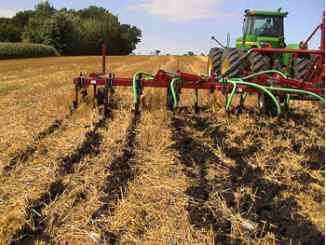
Madison, Wis. – October 19, 2020 – Farmers and forest landowners will want to plan ahead and sign up early for USDA conservation funding. Angela Biggs, USDA Natural Resources Conservation Service (NRCS) State Conservationist in Wisconsin, announced farmers and forest landowners interested in the Environmental Quality Incentives Program (EQIP) need to apply by November 20, 2020, for funding in 2021. Applications are being taken by all USDA Service Centers in Wisconsin. Read more...
The schedule for the Wisconsin Pest Management Update meeting series is listed below. The format will be different this year because of COVID-19. Presentations will include pest management information for Wisconsin field and forage crops. FREE EVENT! 2 CEU Credits in pest management have been approved for each session!
Speakers will include Mark Renz, Nick Arneson, and Rodrigo Werle, Weed Scientists, Damon Smith, Plant Pathologist, and Bryan Jensen, Entomologist.
Schedule:
Tuesday, November 10, 9:00-11:00 AM
Moderator: Jerry Clark, Chippewa County Agriculture Educator
Wednesday, November 11, 11:00 AM-1:00 PM
Moderator: George Koepp, Columbia County Agriculture Educator
Thursday, November 12, 1:00-3:00 PM
Moderator: Josh Kamps, Lafayette County Agriculture Educator
Nov 5 - 10:00 a.m.
Soil itself is a living ecosystem, home to organisms from plant roots, microbes, and fungi, to earthworms, all interacting with each other, and aiding nutrient and water availability to plant life.
Join us to explore how the physical, chemical, and biological properties of soil affect that ecosystem, in our virtual field trip on Soil Health. Learn about research-based soil health practices taught by our University of Arkansas System Division of Agriculture Soils Instructor and hear from the Arkansas Soil Health Alliance and a local farmer about their real-life experiences with improving soil health.
|
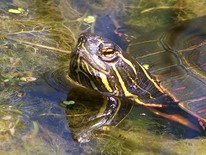
Washington and Waukesha Counties AIS Update - Battle of the Invasives: Rusty Crayfish vs. Northern Crayfish
Outside their home range, rusty crayfish are likely to displace native northern crayfish and reduce aquatic plant abundance and diversity. In some northern Wisconsin lakes, it has eaten most of the aquatic plants, hurting the quality of the lakes. Aquatic plants provide important habitat for fish and other aquatic animals, as well as prevent erosion. By damaging underwater habitat, fish also lose their spawning areas, protective cover and food. Fish that normally eat crayfish don't like the feisty, aggressive "rusty." It takes over the homes of native crayfish and has been known to eat fish eggs. Rusty crayfish reproduce quickly and females lay from 80-575 eggs.
|

Rusty Crayfish: This crayfish measures two and one-half inches (not including claws) in length. Look for their large claws with black bands on the tips and dark, rusty spots on each side of their carapace (hard outer body covering). Their claws are grayish-green to reddish-brown and smoother than most other crayfish.
|

Northern Crayfish: The Northern Crayfish grows to a length of about 10-12 cm, not including the 2 pairs of long antennae or the large chelipeds (pron: "keel-i-peds"), the large claw or pincer bearing legs, that extend forward. The chelipeds often have a bluish tint, particularly in the males which have larger chelipeds and larger pincers than females.
|
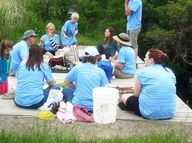
Public Asked To Help DNR Prioritize Work On Water Quality Standards
MADISON, Wis. – The Wisconsin Department of Natural Resources (DNR) is offering the public a chance to rank which issues the DNR should focus on over the next three years to protect water quality in lakes, streams and rivers. This process is called the Triennial Standards Review and is required by the Clean Water Act. The DNR is providing online tools, a comment period and a public hearing to gather public input.
The DNR is asking the public to complete an online form to rank 15 specific topics, indicating which ones should be the DNR’s top 5 priorities.
“The Clean Water Act specifies what types of issues are covered under the triennial review,” said Kristi Minahan, DNR water quality standards specialist. “The topics focus on setting goals for water quality, mainly related to setting thresholds for different types of pollutants.”
The topic ranking form and a description of each topic are available on the DNR’s website starting today. Certain topics are not included in this review.
“While important, the triennial review does not cover topics related to implementation to achieve those goals, like management practices for agriculture or stormwater," said Minahan. "Other DNR programs handle those efforts."
Specifically, topics that will be evaluated in the 2021-2023 review include policies, rules and guidance related to waterbodies’ designated uses, water quality criteria, antidegradation and variances. The list of 15 topics includes some that were suggested by the public and partners in an earlier phase of the process.
The DNR will also hold a public hearing and webinar to describe the topics, answer questions and take comments. The ranking form and any additional comments may be submitted until Dec. 4, 2020. The public hearing will be held online at 1 p.m. on Nov. 16 and may also be joined by phone. Public hearing details are available on the DNR’s public hearings calendar.
After the comment period closes, the DNR will prioritize the topics based on input from the public, technical staff and partners, and prepare a final prioritized list of items to work on over the next three years. The prioritized list is expected to be completed this winter. When the workplan is complete, work will begin on the priority topics.
The DNR appreciates all input on protecting Wisconsin’s water quality. For more information on the Triennial Standards Review process and past reviews, click here.
|

DNR Technical Standard 1010 Proprietary Storm Water Filtration Devices Webinar
Thursday, Nov. 5, 2020 10 – 11 a.m.
Please join Wisconsin Land+Water for a webinar to go over the new DNR Technical Standard of Proprietary Storm Water Filtration Devices (1010). These are commercially available flow-through devices to remove storm water pollutants. They are generally below ground chambers with replaceable granular media cartridges or membrane. The potential use and general sizing of these devices to meet ch. NR 151, Wis. Adm. Code, post-construction performance standards for total suspended solids and total phosphorus will be discussed. 1 Professional Development Hour (PDH) will be offered. Presenter: Eric Rortvedt, Stormwater Engineer – Bureau of Watershed Management, Wisconsin Department of Natural Resources
Register: By noon on Nov. 3 at https://conta.cc/3cx03yn
Urban Nonpoint Source Planning And Urban Small-Scale TMDL Targeted Runoff Management Grant Instructions Now Available For Public Comment
The revised Urban Nonpoint Source and Storm Water (UNPS&SW) Planning Grant application instructions for planning projects beginning in 2022 are now available for public comment on the Department of Natural Resources’ UNPS&SW webpage. The revised Small-Scale Urban Total Maximum Daily Load (TMDL) Targeted Runoff management Grant application instructions for projects beginning in 2022 are now available for public comment on the DNR’s TRM Grant Program webpage.
Send comments to Joanna Griffin, DNR Runoff Management Grants program coordinator at Joanna.griffin@wisconsin.gov by Nov. 9, 2020.
WI Salt Wise is a coalition of organizations from across Dane County working together to reduce salt pollution in our lakes, streams and drinking water. Our primary goals are to: educate residents, leaders and winter maintenance professionals on salt pollution and solutions, provide training and promote best practices to reduce salt pollution and recognize contractors committed to using the right amount of salt for conditions.
2020 Winter Salt Trainings
Winter maintenance professionals directly impact the future of our water. By utilizing proper application rates and techniques, they can support public safety, save money, and protect our freshwater. Local trainings are currently available in Dane, Milwaukee and Waukesha Counties. Don't see your county listed? Send an email to wisaltwise@gmail.com.
|

Public notices are required by law to alert interested members of the public of the DNR's intention to authorize a Wisconsin Pollutant Discharge Elimination System (WPDES) discharge to a water of the state. The notices are posted here on the DNR website for 30 days and are also published once in the legal notices section of the local newspaper in the vicinity of the facility. The notice identifies the facility by name, indicates where the discharge is located and briefly describes the facility's activities.
The multi-discharger variance (MDV) for phosphorus extends the timeline for complying with low-level phosphorus limits. In exchange, point sources commit to step-wise reductions of phosphorus within their effluent as well as helping to address nonpoint sources of phosphorus from farm fields, cities or natural areas to implement projects designed to improve water quality. The MDV is similar to an individual variance. However, multiple point sources can be covered under the MDV, whereas an individual variance only applies to a single facility. This provides for administrative streamlining and maximizes the potential benefits watershed projects may have through the variance program. The MDV factsheet [PDF] provides general information regarding this program. MDV Implementation Guidance [PDF] provides details about eligibility and implementation requirements for this program.
|
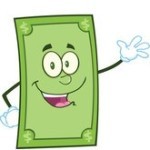
WASHINGTON, October 14, 2020 – USDA’s Natural Resources Conservation Service (NRCS) today re-posted a revised Regional Conservation Partnership Program (RCPP) funding announcement, inviting potential conservation partners to submit project proposals for federal funding. NRCS will award up to $360 million dollars to locally driven, public-private partnerships that improve the nation’s water quality, combat drought, enhance soil health, support wildlife habitat and protect agricultural viability.
The original announcement had stated that “Forest land eligibility does not encompass industrial forest lands that are owned by companies, organizations, and individuals who engage in commercially oriented forest management and production activities.” NRCS has removed this language, which partners may have interpreted as limiting opportunities for RCPP projects on forest lands where eligible activities would help achieve conservation benefits.
NRCS has also extended the proposal deadline to November 30, 2020 at 11:59 p.m. Eastern. To learn more about the opportunity for funding, read the August 6th announcement, and for more information on how to apply, view the Application for Program Funding on grants.gov.
|
|